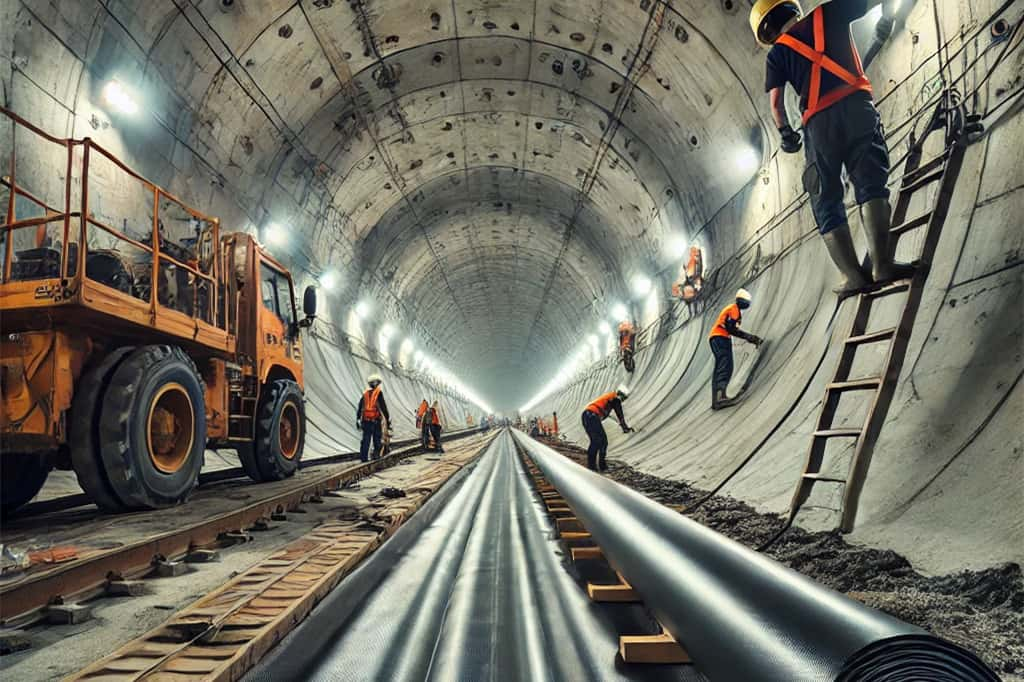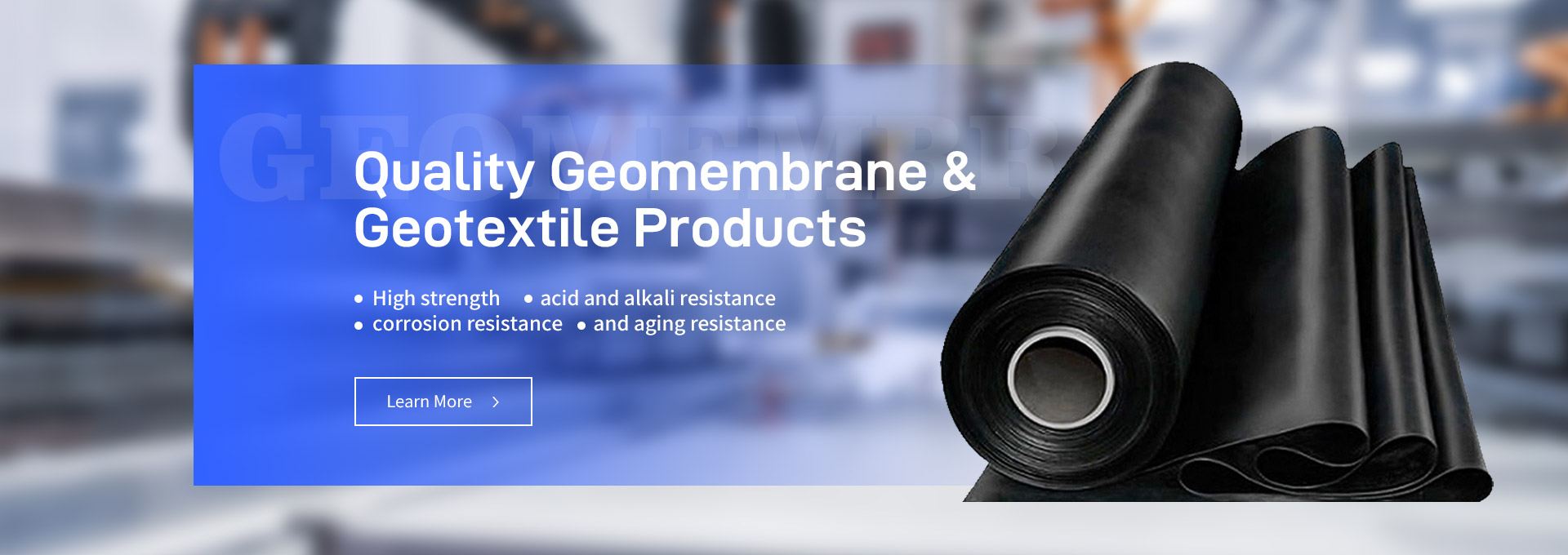In modern construction and infrastructure projects, there is one material quietly playing a heroic role behind the scenes—high-density polyethylene geomembrane. If you’re not too familiar with the term yet, don’t worry. An HDPE geomembrane isn’t some mysterious high-tech gadget, but rather a highly versatile, high-performance waterproofing material. Today, we’ll dive into its application in the construction and infrastructure industries, especially focusing on how it performs in basement waterproofing and tunnel waterproofing.

1. What is an HDPE Geomembrane?
Let’s start with the basics and introduce HDPE geomembrane. High-Density Polyethylene (HDPE) is a polymer material formed by polymerizing ethylene monomers. Due to its high density, strength, and resistance to corrosion, it is widely used for waterproofing and anti-seepage projects. A polyethylene geomembrane is a thin, specially engineered waterproof sheet used in various industries like environmental protection, construction, and transportation.
The core of HDPE geomembrane is that it’s lightweight, durable, and boasts exceptional impermeability. These properties make it a star in underground engineering and infrastructure projects.
2. Key Advantages of HDPE Geomembranes
Before we dive into the application of HDPE geomembrane in construction and infrastructure, let’s take a closer look at why this material is so impressive. Here are some of its main highlights:
Superior impermeability:
HDPE geomembranes have an extremely low permeability coefficient, meaning they are almost completely watertight. This makes them ideal for situations requiring waterproofing, from basements to tunnels and even wastewater treatment plants.
Chemical resistance:
In complex underground environments, contact with various chemicals is inevitable. HDPE geomembranes can resist most chemicals, ensuring they maintain their waterproofing function for long periods.
Durability and strength:
HDPE geomembranes offer excellent tensile strength and can withstand physical impacts. Whether they face mechanical pressure or environmental changes, their durability is unmatched, making them ideal for construction and infrastructure projects.
UV resistance:
While this may not be a concern for underground applications, HDPE geomembranes also have excellent UV resistance. In exposed applications, such as in some infrastructure projects, this adds to their value.
Now that we’ve covered these amazing features, let’s dive into the topic and see how HDPE geomembrane excels in construction and infrastructure, particularly in basement and tunnel waterproofing.
3. Application of HDPE Geomembranes in Basement Waterproofing
Why is Basement Waterproofing So Important?
Let’s start with a question: Who wants to store their precious belongings in a damp, moldy basement? Obviously, no one! Basement waterproofing is crucial because basements often come into direct contact with soil moisture and groundwater. Without proper waterproofing, this can lead to dampness, mold growth, structural damage, and even cracked walls, threatening the overall integrity of the building.
Traditional waterproofing methods, like asphalt sheets or cement mortar waterproof layers, often fail to withstand groundwater pressure or long-term environmental changes. And that’s where high-density polyethylene geomembrane steps in!
HDPE Geomembrane as the Basement Waterproofing Solution
HDPE geomembrane offers extremely high impermeability and mechanical strength, effectively preventing water from seeping into basement walls and floors. It acts as a protective barrier, keeping groundwater firmly outside the structure.
Here’s how it’s applied:
Surface preparation: Before installation, the exterior walls of the basement are cleaned and leveled to ensure the HDPE geomembrane can adhere tightly.
Membrane installation: The high-density polyethylene geomembrane is then laid over the basement’s exterior walls or floors, covering all areas prone to seepage. The seams between the membranes are sealed using specialized welding techniques, ensuring a watertight connection.
Protective layer: To prevent damage to the geomembrane from backfill or other mechanical forces, a protective layer—such as cement mortar or geotextile—is applied over it.
Through these steps, the basement waterproofing issue is resolved. HDPE geomembrane provides long-lasting waterproof protection and remains stable in harsh underground environments, reducing the risks of failure due to material aging or damage.
Additional Advantages of HDPE Geomembranes in Basements
Beyond exceptional waterproofing, HDPE geomembrane offers other key benefits in basement applications:
Mold and chemical resistance: The underground environment can be complex and filled with organic matter and chemicals. HDPE geomembrane remains unaffected by mold and chemical corrosion, ensuring long-term effectiveness.
Ease of installation: While offering superior performance, HDPE geomembrane is not complicated to install. The installation process is efficient, requiring minimal maintenance and saving time and costs.
4. Application of HDPE Geomembranes in Tunnel Waterproofing
Challenges in Tunnel Waterproofing
Compared to basements, tunnel waterproofing takes on a whole new level of difficulty. Tunnels not only face groundwater pressure but also geological water seepage, rock layers, and geological movements. Any failure in tunnel waterproofing can lead to costly repairs or even traffic hazards.
In such a complex environment, choosing the right waterproofing material is critical. Traditional materials, like cement-based waterproof layers, often struggle to withstand long-term water pressure erosion. High-density polyethylene geomembrane, however, with its superior waterproofing capabilities and mechanical strength, is the perfect solution.
How HDPE Geomembranes Are Applied in Tunnels
HDPE geomembrane has extensive use in tunnel waterproofing, mainly applied in the following ways:
Tunnel lining external waterproofing: After tunnel excavation, the HDPE geomembrane is laid over the tunnel's outer walls, creating a continuous waterproof layer. This membrane blocks moisture from entering the tunnel and significantly reduces water pressure on the structure.
Welding and sealing: To ensure complete waterproofing, the seams between the geomembrane sheets are welded together using specialized welding equipment. The hot-melt welding technique creates seamless connections that leave no room for water penetration.
Multi-layered protection system: In some specialized tunnel projects, HDPE geomembrane can be combined with other materials to create a multi-layered protection system. This may include adding a drainage net outside the membrane, which guides water away from the tunnel and reduces pressure on the geomembrane.
Additional Advantages of HDPE Geomembranes in Tunnels
Aside from outstanding waterproof performance, HDPE geomembrane offers the following advantages in tunnel construction:
Safety during installation: Tunnel environments are often narrow and complex, but HDPE geomembrane is lightweight, making installation easier and safer. Its flexibility also helps it adapt to the tunnel’s unique geological conditions.
Reduced maintenance costs: Once installed, the durability of HDPE geomembrane significantly reduces the need for future repairs, saving considerable costs for infrastructure projects.
5. Conclusion
From basements to tunnels, from buildings to large-scale infrastructure, HDPE geomembrane is proving itself to be a "superstar" in modern construction. Whether it’s dealing with harsh underground conditions or withstanding long-term water pressure, HDPE geomembrane consistently delivers exceptional performance.
Looking ahead, with advances in technology and expanding application areas, HDPE geomembrane is poised to play an even greater role in future construction and infrastructure projects. Not only as a waterproofing material but also with potential innovations in sustainability, durability, and even smart monitoring systems.
As a reader interested in this material, we hope this article helps you better understand the power of HDPE geomembranes and their crucial role in construction. Whether you’re an industry professional or an engineering enthusiast, the story of HDPE geomembrane is still unfolding, and its future looks bright. So next time you consider a project, don't forget to consult with geomembrane manufacturers for the best solutions tailored to your needs!

